
Nina Riggs, the Poet, Speaks in Prose for the First and Last Time
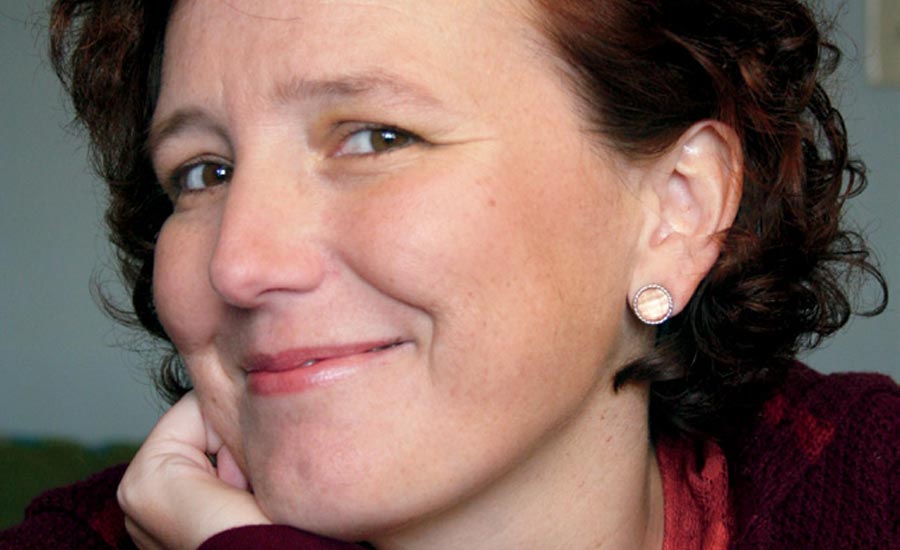
Nina Riggs ’95
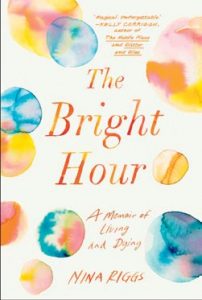 In her newly released memoir, The Bright Hour, Nina Riggs ’95 sets up the terms of engagement right at the outset. “Dying isn’t the end of the world,” Nina reports her mother joking in the months before she died. Shortly thereafter, Nina had to reckon with the truth in her mother’s cryptic humor. While she was still undergoing treatment for breast cancer that had been diagnosed 11 months earlier, Nina’s cancer became metastatic and incurable. She was 38. “There are so many things that are worse than death,” Nina writes, “old grudges, a lack of self-awareness, severe constipation, no sense of humor, the grimace on your husband’s face as he empties your surgical drain into the measuring cup.”
In her newly released memoir, The Bright Hour, Nina Riggs ’95 sets up the terms of engagement right at the outset. “Dying isn’t the end of the world,” Nina reports her mother joking in the months before she died. Shortly thereafter, Nina had to reckon with the truth in her mother’s cryptic humor. While she was still undergoing treatment for breast cancer that had been diagnosed 11 months earlier, Nina’s cancer became metastatic and incurable. She was 38. “There are so many things that are worse than death,” Nina writes, “old grudges, a lack of self-awareness, severe constipation, no sense of humor, the grimace on your husband’s face as he empties your surgical drain into the measuring cup.”
Nina was an accomplished poet—well published, a winner of awards. Her habits of mind and heart served her art form: she was an astute observer, interested in the largest ideas and most trivial of details, a committed listener, a deep thinker. Nina’s sister-in-law and fellow poet, Amelia Wilbur Riggs ’03, says that she “appreciates a generosity in Nina’s poetry and a delight in the world she knows. It’s not all centered in her need for self-explication. It has a lovely groundedness. You can feel her reverence for the real world: what she sees, emotionally, aesthetically. She is clear, witty, imaginative.”
Also front of mind for her family and friends—those from Milton and across Massachusetts, down the East Coast and in her hometown of Greensboro, North Carolina—is Nina the consummate storyteller. “Her stories were vibrant, amazing, hysterical,” says her close friend and Milton roommate Eliza Harrington Myers ’95. “The astonishing thing is that having heard Nina tell them, I’d read them later, and they were even better.”
In The Bright Hour, the storyteller who is a poet or the poet who is telling stories creates and weaves together crystal-clear, memorable images to conjure up a situation or to distill an idea, to deftly highlight an irony, to soothe, to rationalize, to share fear and summon courage.
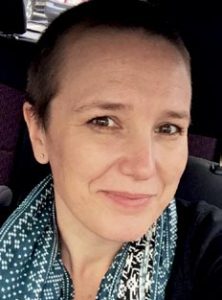
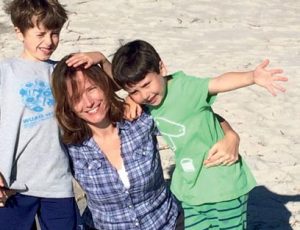 Nina hadn’t planned to write a memoir until her essay, “When a Couch is More Than a Couch,” appeared in the New York Times weekly column and podcast, “Modern Love.” In the essay, Nina searches relentlessly for the perfect “grown-up” couch, after 16 wedded years living with “wellloved misfits.” She’s “propped in bed, on a dozen pillows with her laptop.” An internet fiend, she calls herself, homebound but inspecting every option the most hip furniture stores have to offer, getting to the bottom of the minutiae of construction and fabric and variances of period and style. The couch project is an irresistible, wry entreÅLe into her own and her family’s life: the humorous tenderness with which her husband, John, defers to Nina the decision about whether custom upholstery would be a good idea in a household with two young boys; the pretty comfortable viewing those boys are doing right now on an old futon; the invitation from her husband to lie quietly and “stare at the ceiling” together on the dusk side of a short, gray January afternoon; the silences and what might be happening behind them. As Nina considers contemporary versus midcentury modern, she slips us the facts about the stakes in their lives, the journey looming ahead.
Nina hadn’t planned to write a memoir until her essay, “When a Couch is More Than a Couch,” appeared in the New York Times weekly column and podcast, “Modern Love.” In the essay, Nina searches relentlessly for the perfect “grown-up” couch, after 16 wedded years living with “wellloved misfits.” She’s “propped in bed, on a dozen pillows with her laptop.” An internet fiend, she calls herself, homebound but inspecting every option the most hip furniture stores have to offer, getting to the bottom of the minutiae of construction and fabric and variances of period and style. The couch project is an irresistible, wry entreÅLe into her own and her family’s life: the humorous tenderness with which her husband, John, defers to Nina the decision about whether custom upholstery would be a good idea in a household with two young boys; the pretty comfortable viewing those boys are doing right now on an old futon; the invitation from her husband to lie quietly and “stare at the ceiling” together on the dusk side of a short, gray January afternoon; the silences and what might be happening behind them. As Nina considers contemporary versus midcentury modern, she slips us the facts about the stakes in their lives, the journey looming ahead.
The day after “When a Couch” was published, Brettne Bloom of the Book Group called Nina to inquire about a full length memoir. Two weeks later, Nina signed a book contract to write the manuscript with Marysue Rucci, her editor at Simon & Schuster. Nina began working on the project in September 2016, and completed the roughly 300-page book in late January, just a couple of weeks before her death on February 26, 2017. She wrote with vision and the intention to finish. Her pages warmly welcome us into the intimate relationships that mattered during a highly conscious journey, one that purposefully includes humor, beauty and magic.
“Nina’s images are salient, real, and even recent,” says John.
She writes, for example, of her next-door neighbor’s pristine dark-purple house with the hot-pink columns, where constant yard work tidies and perfects, especially with a leaf blower. “When I was spending a lot of time bald on our back deck—in the throes of chemo and buzzed out of my mind by the steroids, thinking, gardening, breathing, trying to get my footing in a world where I suddenly didn’t feel at home—I would often spend the day next to the sounds of Dan’s labor on the other side of the fence. . . . At one point, as he walked up the back steps to his house, he paused and looked over at me sweeping, he who does not make easy eye contact even when someone is not bald in their pajamas— and we nodded to each other, as though acknowledging that the thing rattling loose in both of us was the same.”
She recounts digging holes together, hiding, laying out identical clothes for the first day of kindergarten with her cousin Bonnie Dundee (also Milton ’95) in Concord, Massachusetts at their ancestor Ralph Waldo Emerson’s family estate. She takes us with her and John, and their boys, Freddy and Benny, to visit Universal Studio’s Portofino Bay in Orlando—two months before her death. “It’s hard to keep track of the different levels of artifice here,” Nina says, “and in some ways it reminds me of my own body. It looks intact—lovely, even, on the outside—but you can sense that on the inside something is not right.”
A meaningful gathering place for Nina is Naushon—the island off the Massachusetts coast, northwest of Martha’s Vineyard, where Nina spent all her summers. On a Labor Day when the “ocean has shifted from hazy gray-green to chilly navy,” to distribute her mother’s ashes, Nina describes the frenetic surviving guinea hen—one of a flock at the start of summer, the others victims of osprey and a fox. “She weaves in and out of the grasses. She does not stop moving until she returns to the roost on her own before dusk each evening. It seems it is not easy to find peace as the last living member of your species at the end of summer on an island in the chilly Atlantic. What must she be thinking? There is no fear as great as her fear. From time to time she lets loose a great squawk, standing at the highest spot on the hill . . . ”
“It was not just the compressed time frame of this undertaking,” John says. “It’s that she never did a project remotely like this. Writing in this style, rather than poetry, might actually have freed her up. She could be much funnier, and yet you still have the lyricism of her language. Her images convey unifying themes and intersect with universal themes. She was rigorous about self-editing, and didn’t abandon any of her long-held standards, regardless of being sick.”
At every turn, The Bright Hour offers stunning ironies that could be parsed forever, but one at the center is the bold, dogged courage Nina shows as she resolutely addresses our collective vulnerability, and hers in particular—now that she is living “with death in the room.”
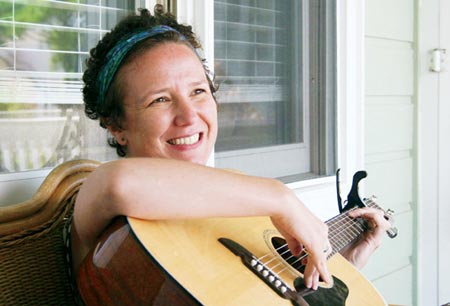 Nina makes no secret of her anxieties—she had always been a worrier. For example, she was never in a bed other than her own without a plan for escape, just in case, she confesses. Whereas John, she says, with smoke in the hallways, alarms ringing and flames licking under the door would finally acknowledge that they might need to leave. Nina relates that a therapist once told her that the only thing that would satisfy her on the internet was finding the website: www.heyninariggseverythingisgoingtobeok.com.
Nina makes no secret of her anxieties—she had always been a worrier. For example, she was never in a bed other than her own without a plan for escape, just in case, she confesses. Whereas John, she says, with smoke in the hallways, alarms ringing and flames licking under the door would finally acknowledge that they might need to leave. Nina relates that a therapist once told her that the only thing that would satisfy her on the internet was finding the website: www.heyninariggseverythingisgoingtobeok.com.
“The physical places in our lives,” John explains, like Naushon, “were stunningly beautiful and also inherently dangerous. The other side of that pervasive sense of absolute beauty was the equally strong awareness that there was no safety net. With the ocean surrounding you, you never forgot that life there is precarious. Existence doesn’t just cruise along. Fragility is a part of anyone’s existence and you have to have it constantly on your mind.”
Nina found solace in a favorite volume of John’s during her two years with breast cancer, Michel de Montaigne’s Essays. Montaigne was no stranger to death during his life in 16th-century France. His younger brother died suddenly at age 23; only one of his six daughters survived infancy; his best friend died “in his arms at the hands of the plague,” writes Nina. Montaigne himself suffered a lifetime of debilitating kidney stone attacks.
“I love about Montaigne,” Nina writes, “that despite roving bands of thieves and constant political upheaval, he reportedly never kept his castle guarded. He left all his doors unlocked. He acknowledged the terror that could come. But by considering it and allowing it in, he resolved to live with its presence. ‘I want death to find me planting my cabbages, not concerned about it—still less—my unfinished garden.’”
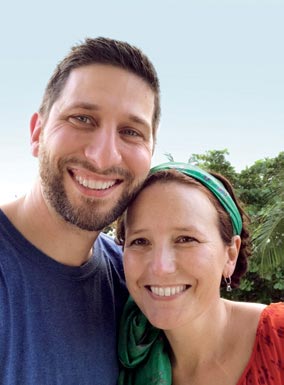
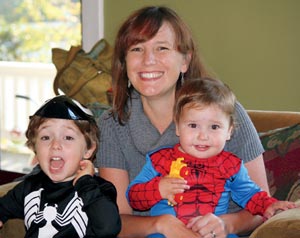 Montaigne was Nina’s muse as she responded to what life turned up, and wrote about it. “She, too, chose to live a life that was exposed,” John notes. “As for the metaphor of his castle, Montaigne lived with the prospect of death by dint of circumstances and also by choice. Nina opened herself up to existential threat at every turn.”
Montaigne was Nina’s muse as she responded to what life turned up, and wrote about it. “She, too, chose to live a life that was exposed,” John notes. “As for the metaphor of his castle, Montaigne lived with the prospect of death by dint of circumstances and also by choice. Nina opened herself up to existential threat at every turn.”
As she makes her way, Nina also weighs the opinions of her great-great-great grandfather, Ralph Waldo Emerson, and the written conversations Emerson had with Montaigne’s writings. Emerson cautions that “life is an apprenticeship to the truth,” that “we must try to see, without understanding,” and “always do what we are afraid to do.” Ultimately, a phrase of Montaigne’s came closest to a mantra for Nina: “‘We have to learn that what cannot be cured must be endured,’” Nina says. “You see why I talk to him all day.”
Nina’s characters are authentic, flawed and heroic. She draws herself, family members and friends so completely that we fully relate to them; we’re intensely aware of the particular roles they play in the reality of Nina’s drama. Throughout the book, Nina refers to her oncologist as “the Queen,” for instance:
The Queen of Triple Negative Breast Cancer: that’s the doctor I have the great fortune of being squeezed in to see for how to treat this aggressive-seeming, hormone-negative tumor, the clinic coordinator at Duke Cancer Center tells me. . . . Dr. Cavanaugh is smart like a switchblade and wears knee-high black boots with her white coat. She looks completely together. She might be my polar opposite.
The Queen’s judgment and care, we learn over time, is a critical, trusted source of clarity for Nina, even when the disease determinedly followed its own confounding course—refusing to meet any expectation and continually delivering blows.
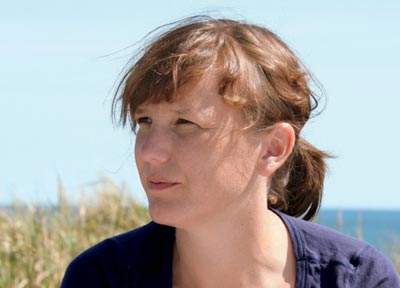 Nina uses perfectly crafted, lively dialogue, family events of the past and future, just the right amount of history, and events within the book’s time frame, to draw the full measure of her characters with relatively short strokes. Working toward the core of what makes her Dad tick, Nina shares key notes about his childhood and then says, “Somehow he grew up into the most competent person I know. He can: ride a horse, head a soccer ball, fry a chicken, fix a washing machine, fix an engine, tether a boat in a storm, dance the foxtrot, build a tree house, work out a tune on the piano, calm a baby, win at rummy. He never complains about anything, even though in my lifetime so far he’s been struck by lightning, been bitten by a brown recluse and lost his life partner.” As so frequently happens in Nina’s writing, this tight little paragraph is more than a clever list: it’s rife with soon-to-emerge metaphors, foreshadowing, insight and irony.
Nina uses perfectly crafted, lively dialogue, family events of the past and future, just the right amount of history, and events within the book’s time frame, to draw the full measure of her characters with relatively short strokes. Working toward the core of what makes her Dad tick, Nina shares key notes about his childhood and then says, “Somehow he grew up into the most competent person I know. He can: ride a horse, head a soccer ball, fry a chicken, fix a washing machine, fix an engine, tether a boat in a storm, dance the foxtrot, build a tree house, work out a tune on the piano, calm a baby, win at rummy. He never complains about anything, even though in my lifetime so far he’s been struck by lightning, been bitten by a brown recluse and lost his life partner.” As so frequently happens in Nina’s writing, this tight little paragraph is more than a clever list: it’s rife with soon-to-emerge metaphors, foreshadowing, insight and irony.
Nina could never resist a story—either ferreting one out from people around her, like medical techs and shoppers at Target—or imagining what would fill in the gaps. She describes her colleague patients in the waiting room at Duke as “The Feeling Pretty Poorlies.” She tracks the presence or absence of a white motor scooter outside the door of a room at the Embers Lodge each time she passes this landmark of the roadway from Durham (Duke) to home in Greensboro. “Lyla,” she names the scooter’s owner, and naturally there is intrigue in Lyla’s life. Amelia tells that even when she had to struggle to breathe, Nina had to share the back story of the wonderful EMT who drove her from Duke to the hospice where she died two days later.
“There was no sharp division between Nina’s domestic self and her artistic self,” John says. “Nina chose to prioritize our voice, our marriage, her boys, her family and friends by design. Nina crafted the role she had as a writer. So she’s left the most amazing legacy anyone could have, for me, for her boys. I think people who read The Bright Hour will get a really true picture of Nina, as an artist and as a person. I’m really glad about that.”
by Cathleen Everett
Author’s note: In addition to Nina’s Milton friends quoted in this article, I would like to thank Christy Plotner ’95. After Nina’s death, Christy helped me understand her own and Nina’s closely allied experience with breast cancer.




